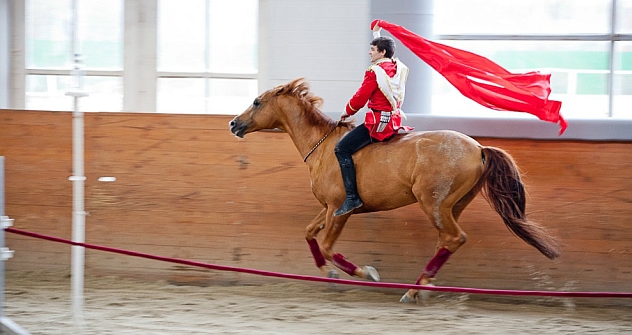
Source: Ruslan Sukhushin
Source: Ruslan Sukhushin
On a recent afternoon in the village of Putilkovo, about 50 miles outside of Moscow, the weather is what might be called typically English, with an overcast sky and drizzling rain. Fortunately, the horses and jockeys of the Kremlin Equestrian Riding School are spared the rain, practicing in their indoor riding hall. They are in final preparations for the Royal Windsor Horse Show, called “The World Comes to Windsor,” which will mark the 60th anniversary of Queen Elizabeth II’s coronation. The Russian contingent at the performance will be made up of a joint team of paramilitary equestrians from the Presidential Regiment’s Cavalry Escort and the Kremlin Equestrian Riding School. It will include 13 riders – 11 men, two women – and 12 horses of indigenous Russian breeds, Donsk and Budyonnovsk. Only three European countries – France, Italy and Russia – will participate in the festivities.
The Kremlin Equestrian Riding School is a modern equestrian complex created to revive the tradition and culture of horseback riding and encourage a healthy lifestyle among Russian youths. In 2011 the School’s team performed at the Spasskaya Tower International Military Music Festival in Moscow’s Red Square, where it was spotted and selected by the organizers of the British horse show.
The Russian team has prepared an eclectic program for the UK. The show “must reflect the culture and traditions of our country,” said Boris Petrov, director general of the Kremlin Equestrian Riding School. So, in addition to riding, the program includes traditional Cossack stunts (acrobatic tricks performed by the rider while racing), choreography and fencing.
At the sound of church bells, riders appear in costumes stylized to look like the full dress uniforms of His Imperial Majesty’s Convoy – red cherkesky (collarless kaftans) and tall white fur hats. At a full gallop, the riders vault over the horse’s body, jump out of and back into the saddle, stand on the horse’s back and ride while releasing the reins. The women make elegant stands on one leg and use a sharp Cossack shashka (a long knife) to cut wooden twigs and bottles with water. In one stunt, two riders, a man and a woman, assume a horizontal position, he on the galloping horse’s back and the woman under the horse’s belly. Stunt riding is the most impressive part of the program and a known skill of Russian equestrians. These tricks were once used by Cossacks in battle, and now the riders will display them before the horse-savvy Windsor public.
The riders stage a fight with wooden spears and display Cossack swordsmanship. All of a sudden the mood changes to one of tenderness, a demonstration of trust between rider and horse. Three jockeys unharness their mounts, leaving only a leather halter on their necks and perform several stunts.
It is hard to say who is in better shape, the riders or their four-legged friends. According to a female rider called Angela, it takes about a year for a horse and a rider to get used to each other. This program was prepared in four months. “Only the best will go to Windsor,” said Pavel Polyakov, the team’s captain.
It will take the team two days and nights to travel the more than 1,000 miles to London. The horses will be brought in special vans accompanied by veterinarians. The team will have four or five days to acclimate and for a dry run of the program.
Source: RBTH TV
All rights reserved by Rossiyskaya Gazeta.
Subscribe
to our newsletter!
Get the week's best stories straight to your inbox